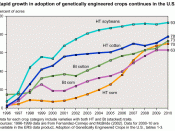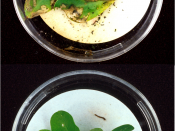Kathy, Brown. 2001. "Seed of Concern",
Scientific American, 284:52-57.
In this article the author addresses the growing concern over the risks of genetically
modified crops and the possible environmental effects that these plants may have in the future.
Presently most genetically modified crops fall into two main categories; those which are
resistant to insect pests because they produce their own toxins, and those which can tolerate a
wide range of weed-killing herbicides in place of harsh pesticides designed to target specific
species. Benefits of genetic modification vary from crop to crop, but generally, GM plants
respond to milder forms of pesticides and often do not need to be sprayed as often as ordinary
plants. As a result, the amount of pesticide residue that runs off into nearby groundwater and
streams may be decreased, or at least less potent.
The author touches on the three principle concerns of genetically modified crops which
are ; the long-term effects of GM plants on non-target organisms, the possible spread of
modifies genes into nearby plants and weeds, and the evolutionary response these plants may
trigger in weeds and insects.
The author stresses that both the risks and benefits of genetic
engineering in agriculture remain vague due to lack of long-term data on GM plants and their
effects on insect-populations, weeds, and other species. Until they gain more insight, scientists
are proceeding with caution and urge farmers to use pesticides responsibly and to intermix
genetically modified plants with unaltered ones.
Reading this article, I got the impression that our knowledge of genetic engineering is
still very limited. Given that the benefits of GM crops are mixed and that the drawbacks and
possible long-term environmental effects remain unknown, I find it hard to understand why they
are being introduced at all. The biological relationships within ecosystems...


